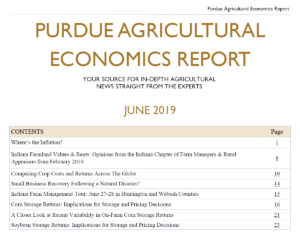Small Business Recovery Following A Natural Disaster?
June 5, 2019
PAER-2019-04
Authors: Renee Wiatt, Family Business Management Specialist, Purdue Initiative for Family Firms and Maria I Marshall, Professor of Agricultural Economics and Director, Purdue Initiative for Family Firms
Small businesses may sometime face extremely difficult situations that can jeopardize survival. In this article we report on some of the characteristics of firms that have survived a natural disaster. The intent is to illustrate management decisions that can assistant any business in getting through the trauma.
After a disaster strikes, insurance is often the first way to obtain funds for recovery costs. Businesses can buy a variety of insurance policies. Policies can include flood insurance, business interruption insurance, business recovery insurance, casualty and property insurance, and other policies specific to the businesses’ needs like inventory insurance. For home-based business, there is also coverage for homeowner insurance including flood insurance, property and casualty insurance.
For this case study, we investigated small businesses in a 10-county area in southeastern Mississippi after Hurricane Katrina in 2005. Of the 347 businesses in this area that survived Katrina, roughly 46% sustained major damage during the hurricane. Of the 116 businesses that closed since Katrina, roughly 63% sustained major damage during the storm.
Results from our research show that small businesses were more likely be operational if the business had property insurance in place before the disaster. Those businesses who sustained major damage from Hurricane Katrina were more likely to go out of business. Although damage from a natural disaster is unavoidable, having insurance in place is within a business owner’s control. Other factors that tended to have a positive association with business survival after the storm included: have been in business for a longer period of time, having a male owner, an owner with a postsecondary education, and having a larger number of employees.
We also examined business “resilience” which we defined as firms that actually grew revenues after the disaster compared to pre-storm levels. Small businesses were more likely to be resilient after Katrina if they had adjusted their insurance policy elections post-Katrina. These adjustments would assure that the business would be better protected in the event of another disruption. Some of the businesses that experienced Katrina were unlucky enough to be hit with an oil spill or Hurricane Isaac less than ten years following Katrina. Other factors that had a positive impact on resiliency included: having a formal legal structure (i.e. corporation or partnership), being married, being male, and having a larger number of employees.
Also, businesses were more likely to achieve higher success after Hurricane Katrina if they owned the property where the business operated and had property insurance in effect before Katrina.
Businesses were less likely to have higher perceived success after Katrina if insurance was unaffordable after the natural disaster. Unfortunately, about 25% of small business owners could not get affordable insurance coverage following Hurricane Katrina. Being married and having more education were also positively related to business resiliency. But, older businesses were less likely to experience higher perceived success after Katrina.
The goal for small business owners should be to have the correct safeguards in place to be able to survive a disaster, to adapt and recover, and to come out other side even better than before. We call this being resilient. Insurance is not the only step that should be taken to protect small businesses, but it is an important one. Having the correct insurance coverage in place can be the difference between survival and demise for a small business.
References:
Marshall, M.I. and Schrank, H.L. (2014). Small business disaster recovery: a research framework. Natural Hazards, 72, 597-616. DOI: 10.1007/s11069-0131025-z.
Acknowledgement:
This article is based upon material from the Purdue University Project “Small Business Survival and Demise after a Natural Disaster”, supported by NSF Grant #0856221-CMMI and “Small Business Disaster Recovery Process: An Analysis of Rural Communities in Mississippi” supported by USDA-NIFA grant # 2011 -67023-30609.
